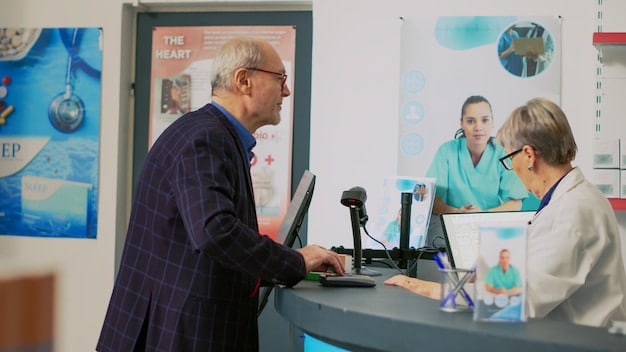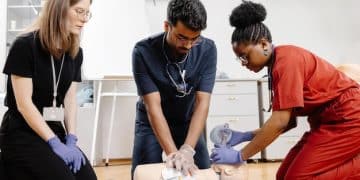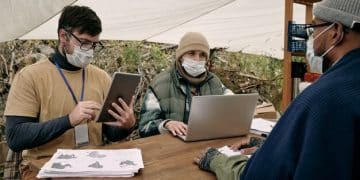The Vital Role of Public Health in Emergency Preparedness

The Role of Public Health in Emergency Preparedness: Lessons Learned and Future Strategies involves crucial actions to protect communities during crises. Public health initiatives enhance preparedness to mitigate the impact of emergencies through planning, response, and recovery efforts.
In times of crisis, the strength of a community often hinges on its preparedness. The role of public health in emergency preparedness: lessons learned and future strategies is not just about reacting to disasters, but proactively planning, training, and implementing measures to protect lives and minimize harm. Understanding the critical intersection of public health and emergency response can transform a community from being vulnerable to resilient, capable of facing unforeseen challenges with confidence.
Understanding the Foundational Role of Public Health in Emergency Preparedness
Public health plays a vital role in safeguarding communities during crises. Its impact spans from initial planning to long-term recovery. Effective emergency preparedness involves proactive measures, coordinated responses, and adaptable strategies.
This section delves into the core responsibilities of public health in emergency scenarios. It explores how these responsibilities translate into real-world actions and community benefits. A well-prepared public health system is essential for community resilience during and after any emergency.
Key Responsibilities in Emergency Situations
Public health agencies have several critical roles during emergencies. These roles ensure community safety and well-being. They also facilitate a smooth and effective response.
- Surveillance and Monitoring: Early detection of disease outbreaks and environmental hazards is essential. Continuous monitoring helps identify and manage potential threats.
- Risk Communication: Providing timely and accurate information to the public reduces panic and promotes informed decision-making. Effective communication builds trust and cooperation.
- Resource Management: Efficient allocation of medical supplies, personnel, and facilities ensures that resources are available where and when they are needed most.

In essence, public health acts as a central nervous system for a community during a crisis. It gathers information, assesses risks, and mobilizes resources to protect public health.
Analyzing Lessons Learned from Past Public Health Emergencies
Examining past emergencies is crucial for future preparedness. Analyzing successes and failures provides valuable insights. These insights inform more effective strategies and better resource allocation.
This section reviews significant public health emergencies. Each example highlights key lessons about planning, response, and recovery. These lessons can guide preparations for future events, allowing for adaptation and improvement to existing protocols.
Case Studies: Significant Public Health Crises
Several past emergencies have shaped our understanding of public health preparedness. Each crisis offers specific lessons about response strategies and community needs. Learning from these events strengthens our ability to handle future challenges.
- SARS Outbreak (2003): Demonstrated the importance of rapid detection and international collaboration. Effective quarantine measures and travel restrictions were crucial in containing the spread.
- Hurricane Katrina (2005): Highlighted the need for robust evacuation plans and accessible healthcare. The disaster revealed significant gaps in disaster response and social support.
- COVID-19 Pandemic (2020-Present): Underscored the necessity of flexible and adaptable public health systems. Vaccine development and distribution became central to managing the pandemic.
By understanding the challenges and successes of these events, public health officials can develop robust plans for future emergencies. These plans should be flexible and adaptable, accounting for the unique characteristics of each potential crisis. **The role of public health in emergency preparedness: lessons learned and future strategies** are key to building resilience in communities.

Future Strategies and Innovations in Public Health Preparedness
The future of public health preparedness increasingly relies on innovative strategies and technologies. This includes advancements in data analytics, communication tools, and medical interventions. These developments can significantly enhance response effectiveness.
This section explores emerging trends and technologies that promise to transform public health preparedness. It examines how these advancements can improve surveillance, response, and recovery efforts. Embracing innovation is critical for meeting the evolving challenges of emergency management.
Emerging Technologies and Their Impact
New technologies are revolutionizing public health preparedness. These advancements offer unprecedented opportunities for improving response efforts and community resilience. Leveraging these tools effectively is key to future success.
- Artificial Intelligence (AI): AI can analyze vast datasets to predict outbreaks and optimize resource allocation. Early warning systems powered by AI can improve response times significantly.
- Telehealth: Remote medical consultations and monitoring can extend healthcare access during emergencies. Telehealth reduces the strain on hospitals and provides care to isolated populations.
- Mobile Health (mHealth): Mobile apps and devices can disseminate critical information and facilitate communication. mHealth tools empower individuals to take proactive steps during crises.
These technologies are not just theoretical possibilities; they are increasingly being integrated into public health systems around the world. As these tools continue to evolve, they will play an ever-greater role in protecting communities from the impact of emergencies. Embracing these innovations is fundamental to the role of public health in emergency preparedness: lessons learned and future strategies.
The Importance of Community Engagement and Education
Community engagement is crucial for effective emergency preparedness. Informed and engaged citizens are more likely to follow guidelines and support public health efforts. Community participation enhances the effectiveness of preparedness initiatives.
This section examines the role of community members in emergency response. It explores how public health agencies can foster community involvement through education, training, and volunteer programs. Empowering communities strengthens their ability to withstand and recover from emergencies.
Strategies for Effective Community Involvement
Engaging the community requires specific strategies that foster trust and collaboration. These strategies ensure that public health initiatives are inclusive and responsive to local needs. Effective community involvement is essential for successful emergency preparedness.
Public health agencies should actively seek input from community members to better understand their needs and concerns. This collaborative approach ensures that preparedness plans are tailored to the specific characteristics of each community. **The role of public health in emergency preparedness: lessons learned and future strategies** is enhanced through community involvement.
Community education is also critical. Public health agencies should provide information about potential hazards and how to prepare for them. This education should be accessible and culturally appropriate, ensuring that all community members can participate effectively. Furthermore, volunteer programs can mobilize community members to support emergency response efforts. These programs provide valuable assistance during crises and foster a sense of community ownership.
By actively engaging community members, public health agencies can build trust and strengthen their ability to respond effectively to emergencies. Community involvement is not just a matter of practicality; it is a fundamental principle of ethical and effective public health practice.
Addressing Health Equity in Emergency Preparedness
Health equity ensures that all individuals have fair opportunities to be healthy. Emergency preparedness must address existing health disparities. Failure to do so can exacerbate inequalities during and after a crisis.
This section examines the importance of incorporating health equity into emergency planning. It explores how public health agencies can identify and address the needs of vulnerable populations. Promoting equity strengthens the resilience of the entire community.
Identifying and Addressing Vulnerable Populations
Certain populations face disproportionate risks during emergencies. Understanding their specific needs is crucial for effective preparedness. Public health agencies must tailor their plans to address these vulnerabilities. Vulnerable populations often include low-income individuals, racial and ethnic minorities, individuals with disabilities, and older adults. These groups may have limited access to resources, healthcare, and information, making them more susceptible to negative impacts during emergencies.
Ensuring equitable access to resources is paramount. Public health agencies should prioritize the distribution of medical supplies, food, and shelter to vulnerable populations. This may require targeted outreach efforts and the establishment of accessible distribution centers. Additionally, disaster response efforts should address existing social and economic inequalities. This includes providing assistance to individuals who have lost their homes or jobs due to the emergency. By advocating for policies that promote health equity, public health agencies can help create a more resilient and just community.
Recognizing and addressing these disparities is essential for creating a truly resilient community. **The role of public health in emergency preparedness: lessons learned and future strategies** must include a focus on health equity.
The Economic Impact of Public Health Emergency Preparedness
Investing in public health preparedness is economically sound. Preparedness reduces the long-term costs associated with emergencies. Proactive measures minimize damage and facilitate quicker recovery.
This section analyzes the economic benefits of public health preparedness. It explores how investments in infrastructure, training, and planning can yield significant cost savings. A well-prepared public health system promotes economic stability.
Quantifying the Benefits of Preparedness
The economic benefits of preparedness are both direct and indirect. Direct benefits include reduced healthcare costs, property damage, and business disruptions. Indirect benefits include increased productivity, improved community morale, and enhanced investor confidence.
Studies have shown that every dollar invested in public health preparedness can yield several dollars in return. This economic impact underscores the importance of prioritizing preparedness in public health planning. Emergency preparedness investments can include the development of robust communication systems, the stockpiling of medical supplies, and the training of healthcare professionals. These investments not only protect public health but also safeguard the economic well-being of communities. Furthermore, preparedness efforts can enhance a community’s attractiveness to businesses and residents. A reputation for resilience and preparedness can attract investment and talent, boosting economic growth. The economic impact of public health preparedness extends beyond immediate cost savings. It contributes to the long-term sustainability and prosperity of communities.
Investing in public health preparedness is not just a matter of saving lives; it is also a matter of promoting economic prosperity. Understanding the economic impact of the role of public health in emergency preparedness: lessons learned and future strategies reinforces the need for continued investment in this critical area.
| Key Point | Brief Description |
|---|---|
| 🛡️ Planning | Proactive strategies vital for effective crisis response. |
| 📢 Communication | Timely, accurate info crucial during emergencies. |
| 📊 Data | Use of data to predict and manage health crises. |
| 🤝 Community | Engaging communities to enhance resilience. |
Frequently Asked Questions
The goal is to protect communities from health threats. This involves planning, responding, and recovering from emergencies effectively, ensuring the health and safety of the population.
Engaged communities understand risks and support response efforts. This ensures that public health initiatives are more effective and inclusive, creating a more resilient population.
The pandemic highlighted the need for flexible public health systems and vaccine distribution strategies. Rapid response and adaptation are essential for managing global health crises effectively.
Technologies like AI and telehealth can enhance surveillance and healthcare access. These tools support faster responses and provide care to isolated communities during emergencies.
It ensures fair opportunities for all during emergencies. Addressing vulnerabilities of specific populations helps to minimize inequalities and promotes a just, resilient community.
Conclusion
The Role of Public Health in Emergency Preparedness: Lessons Learned and Future Strategies extends beyond immediate response; it involves proactive planning and continuous improvement. By incorporating community engagement and addressing health equity, we can build resilience and minimize impact during crises.
Investing in public health infrastructure and innovative technologies will further enhance preparedness. These measures safeguard the well-being of communities and promote long-term economic stability, emphasizing the lasting value of preparedness efforts.





